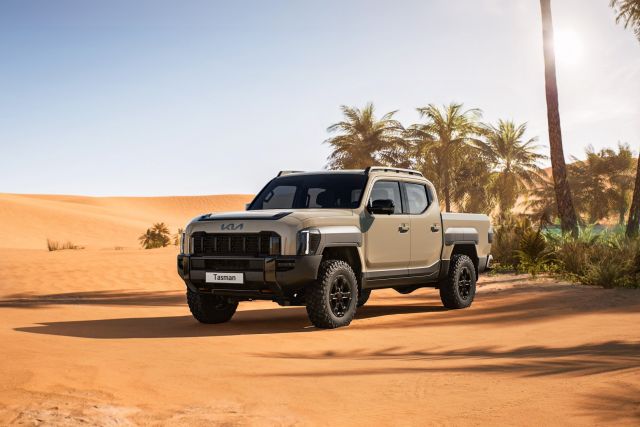
BYD brings affordable PHEV SUV to the market
BYD has added another model to its line-up in South Africa. This time it is the Sealion 5, which slots in below the larger Sealine 6, which is also available locally.
- Product News
- 15 December 2025
Kia’s brand-new double cab bakkie, called the Tasman, could be introduced in South Africa as early as the second half of 2025, says Paul Turnbull, CEO of Kia South Africa.

The Kia Tasman will initially launch in the Korean domestic market during the first half of 2025 before subsequently being introduced in Australia, Africa and the Middle East, with Saudia Arabia expected to be a particularly strong market.
The Tasman makes its world premiere at the Jeddah International Motor Show, introducing Baseline, X-Line and X-Pro Double Cab models.
What is it?
The Tasman is the brand’s first pickup truck that’s said to be ultra-spacious and comfortable, ready for both work and leisure activities across all forms of terrain, including exceptional off-road capability.
Exterior:
The Kia design team deliberately shunned the familiar form language that has dominated the pickup genre for decades.
An expansive radiator grille and bumper design emphasise the pickup’s width, while the hood trim and grille frame the familiar Kia Tiger Face, featuring vertically orientated signature lighting incorporated in the headlamps.
The upright windshield and rear glass contribute to the Kia Tasman’s bold silhouette. The unique fender design combines practical functions, such as headlights and storage units, demonstrating functionality and clear, confident design, says Kia.
Interior:
Just as the Kia Tasman’s exterior aesthetic breaks free from conventional thinking, the robust and rugged space is in keeping with the character of a pickup truck. The interior design leverages concise, symmetrical proportions to create a balanced appearance.
Large air vents featuring a honeycomb pattern – a key theme of the interior – emphasise the functionality of the ventilation. A multi-function steering wheel and the modern, minimalist lower centre dashboard and tunnel sections with carefully positioned buttons provide intuitive control.
Also found inside will be a large folding console table, dual wireless charging pads and hidden storage bins concealed beneath the rear seats offering storage capacity of 33 litres. The Kia Tasman also boasts best-in-segment headroom, shoulder room and second-row legroom of 940 mm, with the rear seats able to recline between 22 and 30 degrees.
Specifications:
The Kia Tasman is offered as a double cab base model and in X-Line and X-Pro trim. The X-Pro provides superior off-road performance thanks to its 28 mm higher ground clearance, which totals 252 mm. It is equipped with 17-inch gloss-black wheels with all-terrain tyres, while the X-Line features larger 18-inch alloy wheels paired with highway and terrain tyres.
Additionally, Kia provides customisable chassis cab variants to meet specific business needs, along with single cab options that optimise bed space by reconfiguring the passenger compartment into a single row layout.
The Kia Tasman will be offered with four-bed accessory configurations: Single Decker, Double Decker, Sports Bar and Ladder Rack, with the first three available immediately from launch.
Drivetrain:
Based upon a fully optimised body-on-frame platform, the Kia Tasman will be offered in Korea with a 207 kW 2.5-litre petrol engine mated to an eight-speed automatic transmission, with 421 Nm of torque.
In the Australian market, the pickup will feature a 154 kW 2.2-litre diesel engine paired with an eight-speed automatic transmission, producing 441 Nm of torque.
In other regions, such as the Middle East and Africa, customers can choose between the 2.5-litre petrol engine equipped with an eight-speed automatic transmission, and a 2.2-litre diesel engine with a choice of an eight-speed automatic or six-speed manual transmissions (depending on market).
Utilising an optimised composite bush structure to mount the Kia Tasman’s body to the frame-type chassis ensures improved rigidity, body control, stability and comfort.
The rear features a rigid axle with leaf springs for optimum robustness and load carrying capability, incorporating vertically mounted shock absorbers to ensure more effective damping and greater control, even at the extremes of suspension travel.
Dimensions:
The Kia Tasman’s load bed is 1 512 mm long, 1 572 mm wide (1 186 mm between the wheels), and 540 mm deep, which provides best-in-class cargo capability of 1 173 litres (VDA). Thanks to a multi-skeleton, highly strengthened bed structure, the Kia Tasman can carry a maximum payload of 1 195 kg in 2WD mode, in addition to a 3 500 kg towing capacity.

BYD has added another model to its line-up in South Africa. This time it is the Sealion 5, which slots in below the larger Sealine 6, which is also available locally.

Geely has formally returned to the South African market with the introduction of two new models, the fully electric E5 and the plug-in hybrid E5 EM i.

Renault’s Capture is celebrating its tenth birthday with the launch of a new version. Internationally, over two million Capturs have been sold so far.